aug 15, 1853 - 1) Lunacy Regulation Act 2) Care and Treatment of Lunatics Act 3) Lunatic Asylums Act
Description:
1) 16 & 17 Vict., c. 702) 16 & 17 Vict., c. 96
3) 16 & 17 Vict., c. 97
«The 1853 Lunatics (Amendment) Act obviated the need for certification for those transferred from one institution to another, creating in its place a transfer order.36 Under this system, medical officers of the discharging asylum were
obliged to send duplicates of the original certificate to the medical officer of the receiving asylum. In addition to the section of certificates which asked for the ’indications of insanity’ given by medical practitioners, this Act added a section on ’indications of insanity’ given by others; This addition of other testimonies had operated informally for decades at the York Retreat, which in 1818 formalized its certificates to include sections for both a medical practitioner and the patients’ family members.
Regardless of the route whence the insane person came, admission to any asylum was still dependent upon the certification by qualified medical practitioners. Thus the certificates originally stated that only those persons licensed as ’physicians, surgeons or apothecaries’ were eligible to fill in the
details. After the medical profession created a unified registration system in 1858, the next Lunatic Amendment Act, in 1862, substituted ’those licensed under the 1858 Act’ for ’physician, surgeon or
apothecary’.39 Several
measures were written into the Lunacy Acts to
safeguard against possible
collusion, either between families and medical practitioners, or between medical practitioners and operators of private licensed homes. Thus, any medical practitioner with an
interest, or with a close relative with a direct
interest, in a private licensed home could not
legally sign a document for a patient to be taken into that same home, nor could a medical officer of any institution sign a certificate for an admission to his own asylum. In cases of
non-pauper certificates, the two medical men could not be in practice together, nor could they examine the person at the same time. For pauper patients the signing medical practitioner (before 1853) could not even be the official medical office of the inmates’ parish or union of settlement. Certificates had to be signed within seven days of confinement or they were
invalid. In an emergency, a patient could be admitted with only one signature, provided a second and third signature were added within three days. Lastly, any signing medical practitioner showed to have deliberately falsified a statement was guilty of a misdemeanour» (Wright, 1998, p. 275).
Added to timeline:
Date:
aug 15, 1853
Now
~ 172 years ago
